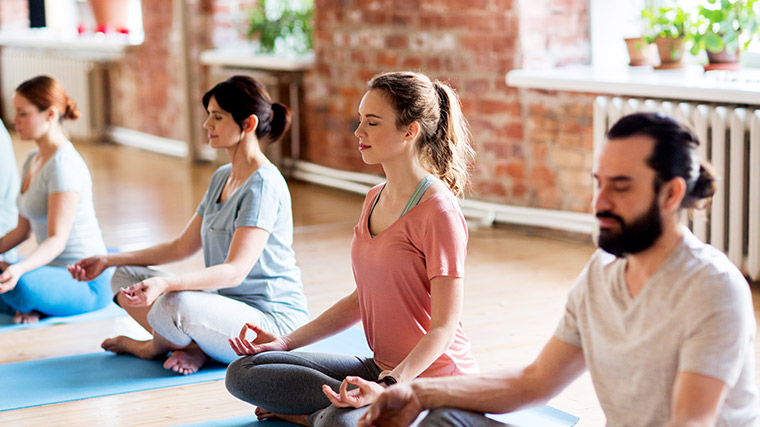In today’s world, full of rush, stress, and sensory overload, more and more people are choosing yoga as a way to take care of themselves – both physically and emotionally. There are many styles of yoga, such as Ashtanga, Hatha, and Vinyasa. In this article, we explain how the different types of yoga differ from one another to help you choose the practice that suits you best.
Yoga is more than just asanas
Many people still associate yoga mainly with stretching, flexibility, and difficult poses that seem out of reach. Meanwhile, the true essence of yoga goes much deeper. It is not just a physical practice, but above all a tool for working with the body, breath, and mind.
Traditionally, yoga involves several elements:
● asanas (physical practice),
● pranayamas (breathing techniques),
● meditation,
● yamas and niyamas (the yogi’s ethical code),
● kriyas (cleansing techniques),
● mantra chanting,
● svadhyaya (spiritual development).
Yoga is a holistic practice that integrates physical, emotional and spiritual aspects. When practised regularly, it not only supports health and wellbeing but also helps you get to know yourself better – your needs, limitations, tensions, and true desires. It is a path that teaches attentiveness, patience and acceptance of one's boundaries.
Yoga has more than one name – discover the types of yoga
Below, we present descriptions of the most popular types of yoga and their key characteristics, which may help you choose the right practice.
1. Ashtanga – sequence and discipline
Ashtanga Yoga is a demanding, dynamic practice based on fixed, repetitive sequences of poses (asanas) combined with breath work. The name “Ashtanga” refers to the eightfold path of yoga described in the “Yoga Sutras of Patanjali”, which includes not only physical exercises but also ethical principles, breath control, meditation, and self-awareness.
This practice focuses on strengthening the body, improving concentration, and achieving meditative calm. The key elements include rhythmic ujjayi breathing (the breath of fire), activation of bandhas (internal energy locks), and gaze focus (drishti) on specific points.
For whom?
● for people who enjoy dynamic and intense activity,
● for those who value structure and discipline,
● for those seeking calm through intensive movement,
● for those who want to strengthen the body and increase flexibility.
2. Hatha – calm and stillness
This style of yoga is an ideal choice for beginners. It is a calm practice that focuses on holding asanas for longer periods and transitioning between them slowly. Traditional Hatha Yoga emphasises improving strength and stretching, with less focus on the metaphysical aspect.
For whom?
● for people who are looking for a calm, gentle introduction to the world of yoga,
● for people who want to improve flexibility, strength and focus more on the physical aspect of yoga (asanas),
● for beginners,
● for people who are returning to practice after a long break.
3. Vinyasa – dynamism and flow
It is one of the most popular styles of yoga and is characterised by its dynamism and the seamless connection between movement and breath. The most important thing here is the harmonious, dance-like transitions between asanas. This form of yoga is often referred to as 'meditation in movement' because it requires focus, coordination and conscious presence. It is characterised by freedom and creativity in building sequences, making each practice a unique experience.
For whom?
● for people who need a dynamic, energetic practice,
● for those who want to develop strength, flexibility, and build a stronger body,
● for lovers of creative sequences.
4. Yin – relaxation and flexibility
A calm, meditative practice that focuses on long, passive holds in poses (even for several minutes). Its main goal is to stretch and soften deep tissues (working on the fascia). Poses are held in stillness, which helps increase range of motion, joint mobility, and provides stability and safety. During stillness, working with the breath is also essential, as it penetrates deeper into the tissues, “nourishing and oxygenating” them.
For whom?
● for people who engage in dynamic sports or intensive yoga practice,
● for people who need to stop, calm down and relax,
● for those in need of relaxation,
● for people who want to deepen their work with the body and emotions.
5. Nidra – yogic sleep
Yoga Nidra is a practice of deep relaxation that allows one to reach a state between sleep and full consciousness. Relaxation usually takes place in a comfortable lying position, with the teacher’s voice playing a key role. The meditation technique itself aims to calm the sympathetic nervous system, which is activated in stressful situations, while supporting the parasympathetic nervous system responsible for rest, relaxation, and digestion.
For whom?
● for people struggling with stress and fatigue,
● for people who have trouble sleeping,
● for anyone in need of deep restoration and inner calm.
Key question before selection
If you are new to yoga, it is worth asking yourself: "What does my body need most at the moment? Rest, reinforcement or perhaps deep relaxation?". It is also worth bearing in mind that finding the right teacher – someone who resonates with you and encourages you to delve deeper into your chosen style of yoga – usually takes time and patient exploration. Keep searching, exploring, and do not give up – “When the student is ready, the teacher appears!”



.svg)





